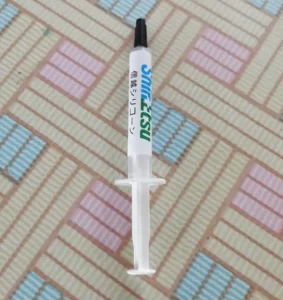While thermal paste plays a crucial role in ensuring efficient heat transfer from the processor to the cooler, improper application can lead to CPU damage and even harm other computer components. If the thermal compound contacts inappropriate areas, it can cause short circuits. Excessively applied paste can actually serve as a barrier, diminishing heat transfer efficiency. Therefore, mastering the correct application of thermal paste is of utmost importance.
How Much Thermal Paste on CPU?

Applying the right amount of thermal paste is crucial for optimal heat transfer between the CPU and the cooler. Too little can result in inadequate coverage, while too much can spill over and possibly create a mess. Generally, follow the principles below.
- For Most Desktop CPUs: A pea-sized amount (or a grain of rice) in the center of the CPU is often recommended. When the cooler is pressed down, it will spread the paste outward, covering the CPU’s surface. The pressure from the cooler will help spread the paste evenly.
- For Larger CPUs: For CPUs that have a larger surface area (like some high-end AMD Threadripper or Intel Xeon CPUs), you might want to use a bit more paste or even consider using a line or X pattern to ensure full coverage.
- For CPUs with Integrated Heat Spreaders (IHS): The primary goal is to have the thermal paste cover the IHS where the actual cores are located underneath. This is typically the center of the IHS, but the exact location can vary depending on the CPU model.
- Check Cooler Instructions: Sometimes, the cooler manufacturer will provide specific instructions or recommendations for applying thermal paste, especially if it comes with pre-applied paste.
The key is to have enough paste to ensure good coverage without it spilling excessively over the sides when the cooler is mounted.
Can too Much Thermal Paste Cause Overheating?
Too much thermal paste can indeed cause overheating. While thermal paste is designed to fill the microscopic gaps between the CPU and the cooler to aid in heat transfer, it’s not as effective at conducting heat as a direct metal-to-metal contact. So, if you apply an excessive amount, it can act as an insulator, impeding the heat transfer rather than assisting it. Additionally, applying too much can lead to air bubbles getting trapped in the paste. These bubbles further reduce heat transfer efficiency. It’s also worth noting that if the paste spills over the edges, it might not cause overheating directly but can create other complications, especially if the paste is conductive.
Will Thermal Paste on CPU Pins Damage the CPU?
Thermal paste on the CPU pins can be problematic. The pins are meant for electrical connections, and having paste on them can disrupt the proper electrical contact between the CPU and the motherboard socket. If the thermal paste is electrically conductive, it can potentially cause short circuits, leading to damage. Even if the paste is non-conductive, it can still prevent proper pin contact. It’s crucial to clean any accidental thermal paste spills on the pins before inserting the CPU into its socket. Always handle the CPU with care and avoid getting contaminants on the pins.
You may also like: How Delicate Are CPU Pins?
Can Thermal Paste Damage CPU Pins?
Is it OK if Thermal Paste Gets on the Motherboard?
If thermal paste gets on the motherboard, whether or not it’s okay largely depends on the type of thermal paste and the amount that has spilled:
Non-Conductive Thermal Paste: Most standard thermal pastes are non-conductive. If a small amount gets on the motherboard, it’s generally not going to cause any immediate harm. However, it’s best to clean it up and keep the motherboard clean.
Conductive Thermal Paste: Some high-performance thermal pastes, especially those containing metals like silver, can be electrically conductive. If these make contact with the motherboard, especially around solder points, traces, or pins, they can cause short circuits.
How to Remove Thermal Paste?
Steps to take if thermal paste spills on the motherboard:
- Power Off: If the system is running and you notice a spill, shut it down immediately.
- Unplug the System: For added safety, unplug the system from its power source.
- Clean the Spill: Use isopropyl alcohol (preferably 90% or higher) and a lint-free cloth or q-tip to carefully clean away the thermal paste. Isopropyl alcohol evaporates quickly and is excellent for cleaning electronics.
- Inspect the Area: Once cleaned, inspect the area to ensure all the paste has been removed. If the spill was near any sockets (like the CPU socket), be especially thorough in your inspection.
- Dry Before Powering: If you used any cleaning solution, ensure the motherboard is completely dry before turning the system back on.
You may also like: Can 99% Isopropyl Alcohol Safely Clean CPU Thermal Paste?
Best Thermal Paste
Here, I’ve found some popular thermal pastes, hoping it might be helpful to you.
Arctic MX-4: Known for its longevity and ease of application. It’s non-conductive and has been a favorite among PC builders for years.
Thermal Grizzly Kryonaut: Offers excellent thermal conductivity and is often used in high-performance and overclocking scenarios.
Noctua NT-H2: The successor to Noctua’s acclaimed NT-H1, the NT-H2 boasts improved thermal performance and extended longevity.
Gelid Solutions GC-Extreme: Popular in both the enthusiast and overclocking communities for its high thermal performance.
Cooler Master MasterGel Maker: Known for its nano-diamond particles, which allow for improved thermal conductivity over some competitors.
